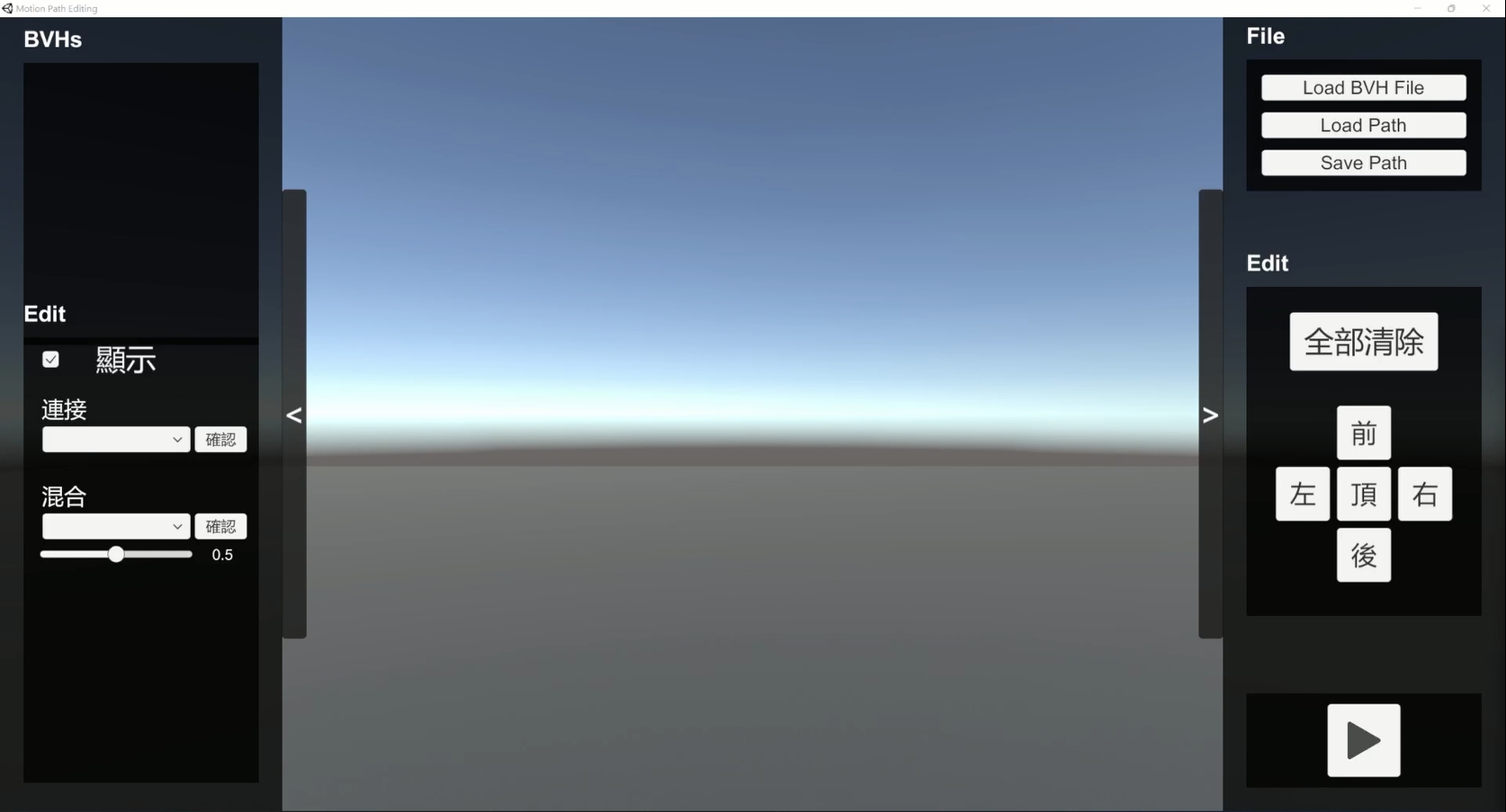Motion Path Editong
專案介紹
臺灣科技大學資訊工程系 3D 電腦遊戲設計(I)第一個專案。
團隊成員: 2 人
透過設置路徑點,可以讓已經套用動畫的模型依照路徑前進,並配合路徑長度播放完整的動畫。專案同時包含載入模型、讀取 BVH 檔、調整路徑與模擬。
操作方法

MENU-File
讀取 BVH 檔案 / 存取 路徑檔案。
MENU-Edit
清出場景、相機控制、播放。
MENU-List (左邊)
選取場景中不同的 BVH。
MENU-Edit (左邊)
指定 BVH 的顯示與否、Motion 連接、Motion blend。
畫面截圖




操作影片
連結
技術文件
讀取 BVH
BVH 檔案分成兩個區塊,HIERARCHY 與 Motion
- HIERARCHY 表示骨骼的位置、旋轉、子骨骼等資訊,其中 CHANNELS 表示骨骼使用到的維度資訊,position 表示位置、rotation 表示旋轉。
HIERARCHY
ROOT Hips
{
OFFSET 0.00 0.00 0.00
CHANNELS 6 Xposition Yposition Zposition Zrotation Xrotation Yrotation
JOINT LeftHip
{
OFFSET 3.430000 0.000000 0.000000
CHANNELS 3 Zrotation Xrotation Yrotation
JOINT LeftKnee
{
OFFSET 0.000000 -18.469999 0.000000
CHANNELS 3 Zrotation Xrotation Yrotation
JOINT LeftAnkle
{
OFFSET 0.000000 -17.950001 0.000000
CHANNELS 3 Zrotation Xrotation Yrotation
End Site
{
OFFSET 0.000000 -3.119999 0.000000
}
}
}
}
}
- MOTION 表示整個動畫每一個 frame 所有骨骼的旋轉,因為骨骼每一塊都是固定連接的,所以除了 root 以外不會有位置資訊。其中每一行的數字對應到 HIERARCHY 中美一塊骨骼的 CHANNELS,一行表示一個 frame。
MOTION
Frames: 20
Frame Time: 0.033333
0.00 39.68 0.00 0.65 -14.85 -0.72 6.03 18.85 -1.96 1.84 1.50 13.41 -3.84 -3.16 1.70
0.00 39.68 0.00 0.62 -14.79 -0.82 6.08 18.81 -1.97 1.73 1.48 13.56 -3.84 -3.33 1.69
因此讀取 BVH 時需要儲存 HIERARCHY 與 MOTION。
我們先為整個 BVH 定義兩個 class 來儲存資料,第一個是 BVHJoint,表示一個骨骼,當中包含 Channels 的順序、MOTION 中的對應數值,實際物件 GameObject 的骨骼以及父節點。
public class BVHJoint : MonoBehaviour
{
public const string XPosition = "Xposition";
public const string YPosition = "Yposition";
public const string ZPosition = "Zposition";
public const string XRotation = "Xrotation";
public const string YRotation = "Yrotation";
public const string ZRotation = "Zrotation";
public BVHJoint parentJoint;
public List<string> channels = new List<string>();
public List<Dictionary<int, float>> frames = new List<Dictionary<int, float>>();
public Dictionary<string, GameObject> bones = new Dictionary<string, GameObject>();
第二個則是整個 BVH,儲存一些像是 MOTION 中 frame time 與 Frames,儲存所有骨骼以及未來需要用到的路徑資料。
public class BVH : MonoBehaviour
{
public PathManager pathManager;
public List<string> motionString = new List<string>();
public BVHJoint jointPrefab;
public GameObject bonePrefab;
public int MoveSpeed = 5;
public BVHJoint root;
public List<BVHJoint> joints;
private int frameNumber;
private float frameTime;
public List<Vector3> originPathPointOrientation;
private List<Vector3> pathPoints;
private List<Vector3> orientationPoints;
讀取時,首先對於 HIERARCHY,逐行讀取,一開始會讀到 ROOT,表示整個骨骼的根節點,繼續讀取得到 OFFSET 和 CHANNELS,因為是 ROOT 所以 OFFSET 基本上都是 0,而 CHANNELS 則有六個,XYZ 的位置和旋轉。
接著讀到 JOINT,表示一個新的子節點骨骼,接著一樣得到 OFFSET 和 CHANNELS 直到最後一個節點會得到 End Site 表示結束。
if (inputs[0] == "ROOT")
{
jointName = line.Split(' ')[1];
bvh.AddRoot(inputs[1]);
yield return null;
}
else if (inputs[0] == "OFFSET")
{
Vector3 offset = new Vector3(Convert.ToSingle(inputs[1]), Convert.ToSingle(inputs[2]), Convert.ToSingle(inputs[3]));
bvh.SetJointOffset(jointNames[jointNames.Count - 1], offset);
}
else if (inputs[0] == "CHANNELS")
{
List<string> channels = new List<string>();
for (int i = 0; i < Convert.ToInt32(inputs[1]); i++)
{
channels.Add(inputs[i + 2]);
bvh.motionString.Add(jointName + " " + inputs[i + 2]);
}
bvh.SetJointChannels(jointNames[jointNames.Count - 1], channels);
}
// 新的關節
else if (inputs[0] == "JOINT")
{
// 堆疊最上層為父關節
jointName = inputs[1];
bvh.AddJoint(inputs[1], jointNames[jointNames.Count - 1]);
yield return null;
}
else if (inputs[0] == "End")
{
jointName = jointNames[jointNames.Count - 1] + " End Site";
bvh.AddJoint(jointName, jointNames[jointNames.Count - 1]);
}
實現動畫
有了資料之後就要依照MOTION中的資料來實現動畫,透過每一個frame time來給每一個骨骼新的旋轉。同時,如果只套用MOTION中的資料,動畫會有明顯一格一格切換的頓感,所以我們再為每個Frame再插入更多Frame,利用線性插值的方式取得兩個資料間的數值並套用上去,得到更順滑的動作。
接著只要依序呼叫每個BVHJoint.UpdateToFrame即可。
public void UpdateToFrame(int frameNumber, float time)
{
if (frameNumber >= frames.Count)
return;
Dictionary<int, float> frameData = frames[frameNumber];
// 取得下一次的旋轉
Vector3 next = GetRotation(frameNumber, frameData).eulerAngles;
// 取得下一次的位置
Vector3 position = GetPosition(frameNumber, frameData);
Vector3 interpolated = next;
// 線性插值
// 公式: x = x0 + (x1 - x0)t
if (frameNumber > 0)
{
Vector3 now = GetRotation(frameNumber - 1, frameData).eulerAngles;
interpolated = now + time * (next - now);
}
transform.localPosition = position;
transform.localRotation = Quaternion.Euler(interpolated);
}
綁定人物
BVH中的骨骼可以用來對應到實際的模型,找要找到骨骼名稱間的對應關係即可。這邊使用UnityChan來作範例。
private Transform SearchHumanBoneTransformByName(string name)
{
HumanBodyBones temp = new HumanBodyBones();
switch(name)
{
case "Hips":
temp = HumanBodyBones.Hips;
break;
#region 左下半邊 ( 跟 Motion 的資料顛倒 )
case "LeftUpLeg":
case "LeftHip":
temp = HumanBodyBones.RightUpperLeg;
break;
case "LeftLowLeg":
case "LeftKnee":
temp = HumanBodyBones.RightLowerLeg;
break;
case "LeftFoot":
case "LeftAnkle":
temp = HumanBodyBones.RightFoot;
break;
// -----
}
}
同樣的不斷更新資料上去來移動人物。
public void UpdateMotionPos(GameObject people)
{
int CurrentIndex = 0;
BVH bvhPeople = people.GetComponent<BVH>();
BVHJoint[] joints = bvhPeople.joints.ToArray();
for(int i = 0; i < joints.Length; i++)
{
Transform TempBonesTran = SearchHumanBoneTransformByName(joints[i].name);
if (TempBonesTran == null)
{
Debug.Log("No match: " + joints[i].name);
continue;
}
// 把 Motion 套上去
Quaternion org = new Quaternion(MotionPos[CurrentIndex * 4],
MotionPos[CurrentIndex * 4 + 1],
MotionPos[CurrentIndex * 4 + 2],
MotionPos[CurrentIndex * 4 + 3]);
Joints[CurrentIndex++].transform.rotation = joints[i].transform.rotation * org;
}
// 位移
Vector3 pos = joints[0].transform.localPosition;
if (!IsSetOffsetY && pos != Vector3.zero)
{
OffsetY = pos.y;
IsSetOffsetY = true;
}
pos.y -= OffsetY;
this.transform.localPosition = pos;
}
連接
兩個BVH檔的動作可以做連接,來得到一個更長的動畫,首先從第二個動畫的前幾個frame當中,找出與第一個動畫的最後一個frame最接近的frame,將兩個frame中間做插值後連接上去。
